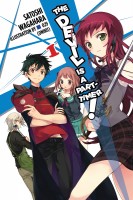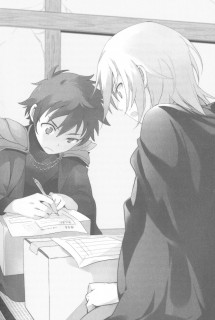 Author: Yukito Ayatsuji
Author: Yukito Ayatsuji
Translator: Karen McGillicuddy
U.S. publisher: Yen Press
ISBN: 9780316339100
Released: October 2014
Original release: 2009
Another is a horror mystery novel written by Yukito Ayatsuji which was originally serialized in Japan between 2006 and 2009 before being collected into a single volume later that year. The novel was then released again in 2011 in two separate volumes. It is that edition upon which the English translation by Karen McGillicuddy is based. Another was initially released digitally in English by Yen Press in two volumes in 2103, but in 2014 it was published as a single-volume hardcover under the newly established Yen On light novel imprint. In addition to being Ayatsuji’s first novel to be translated into English, Another is probably his most widely-known work, especially outside of Japan. This is in part due to the fact that Another was adapted as a manga series and as an anime series, both of which have been licensed in English, as well as a live-action film. Although I’ve known about Another for a while, it actually wasn’t until I read Ayatsuji’s debut novel The Decagon House Murders that I was inspired to pick it up.
Yomiyama North Middle School’s third-year Class 3 is cursed. For some strange reason, the students of that class and their immediate families seem to be more susceptible to dying. Some years pass by without any casualties while other years see multiple deaths every month. The curse is said to be tied to an incident which occurred twenty-six years ago. A popular student named Misaki died, but the entire class was in such denial that Misaki’s spirit manifested. Now more than two decades later, Misaki’s story has been embellished and retold so many times that it’s difficult to tell how much of it is rumor and urban legend and how much is really true. Koichi Sakakibara recently transferred into Class 3 and isn’t sure what to believe and nobody is being particularly forthcoming about the situation. The curse could just simply be a ghost story, but his classmates and teachers are honestly frightened of something. And soon after Koichi’s arrival, a new series of deaths begin.
Another is a marvelous combination of mystery and horror. The first half of the novel explores the “what” and “why” of the increasingly odd situation while the second reveals the “how” and “who.” As a transfer student, Koichi is an outsider. He isn’t as knowledgeable as the other people involved, and they are reluctant to share information with him, so Koichi is largely left to investigate on his own. Eventually he gains some dubious allies, the most important being a young woman named Mei Misaki who may or may not actually exist. Ayatsuji excels at creating a constant air of uncertainty in Another—he introduces just enough creepiness and doubt that readers, like Koichi, are left questioning everything. While logical analysis is a valid option, the weirdness of the situation and the possibility of supernatural interference makes the more mundane, straightforward answers feel suspect. Additionally, Koichi himself is shown to be a somewhat unreliable narrator, and it’s his perspective of the unfolding events that drives Another.
Ayatsuji is particularly well-known for his inventive stories with dramatic twists. Another definitely falls into that category, the plot taking multiple clever and surprising turns over the course of the novel. However, without spoiling things, there was one major reveal towards the end that left me feeling cheated, especially when most of the other developments were so engaging. Retrospectively, the reveal does fit into the overall narrative, and there were some clues hinting at it scattered throughout the novel, but it isn’t foreshadowed as well as it could have been. As a result, I found it to be very unsatisfying. The revelation is shocking and certainly leaves an impact, but I think that had the information been shared earlier in the novel it could have been used even more effectively. Despite this one notable complaint, I actually quite enjoyed Another. The mystery was intriguing, the horror was disconcerting, and blended together they formed a chilling novel that was highly readable and kept me eagerly turning the pages.


